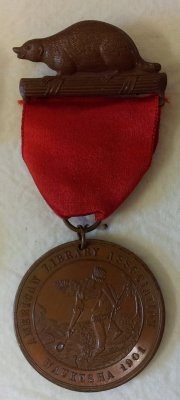Later this week the Wisconsin Association of Public Libraries, a division of the Wisconsin Library Association, will be meeting in Oshkosh for its
spring conference. The legal authority for the establishment of public libraries in Wisconsin was the
public library law of 1872. The first public library established under this law in Wisconsin was the
Black River Falls Public Library. The second public library established under the law was the Sparta Public Library which was established in 1874 (see postcard above). Public libraries that followed soon after were the Eau Claire Public Library (1875), the Madison Public Library (1875), the Fond du Lac Public Library (1876), the Marinette Public Library (1878), and the Milwaukee Public Library (1878). Other early public libraries were the Janesville Public Library (1883), the Neenah Public Library (1884), the Beaver Dam Public Library (1885), the Bayfield Public Library (1886), the Hayward Public Library (1887), the Green Bay Public Library (1888), the Wisconsin Rapids Public Library (1890), and the Chippewa Falls Public Library (1891), the Merrill Public Library (1891), and the Washburn Public Library (1891). The dates of establishment for these public libraries are based on the Fifth Biennial Report of the Wisconsin Free Library Commission. It should be pointed out that there are some questions about the exact dates of establishment of early Wisconsin public libraries. An excellent research paper titled Public Library Development in Wisconsin: 1872-1900 by Karla Fingerson (unpublished, December 12, 1971) explores those questions. It should also be noted that free public libraries established under the law of 1872 were preceded by
fee based membership libraries in many Wisconsin communities. Also, some early public libraries operated under privately appointed library boards and were not established under the 1872 law.




 Increase A. Lapham (1811-1875) is considered to be Wisconsin’s pioneer scientist and scholar. In addition to his scientific endeavors, Lapham was a supporter and contributor to Wisconsin’s library collections. His efforts in this regard included: helping to found the Wisconsin Historical Society; helping to found the Wisconsin Academy of Science, Arts and Letters; and developing a personal library of over 1,100 volumes that became part of the library of the University of Wisconsin in 1876. One of Lapham’s most interesting contributions to libraries involved his role in establishing a school library in Milwaukee in 1851. At the time Lapham was one of the Milwaukee school commissioners and he led the effort to establish the library. After a resolution proposed by Lapham to create the library was approved by the school commissioners, Lapham moved quickly to establish the library. This included selecting and ordering 704 books costing $371.61. A librarian was recruited by Lapham and paid fifty dollars a year. The library was located in the building of Milwaukee’s Young Men’s Association and was open for business on Saturday afternoons. The early enthusiasm for the library gradually dissipated, and only thirty more books had been acquired by 1857. In 1878 the Young Men’s Association Library became part of the new Milwaukee Public Library and over the years the original school library collection disappeared.
Increase A. Lapham (1811-1875) is considered to be Wisconsin’s pioneer scientist and scholar. In addition to his scientific endeavors, Lapham was a supporter and contributor to Wisconsin’s library collections. His efforts in this regard included: helping to found the Wisconsin Historical Society; helping to found the Wisconsin Academy of Science, Arts and Letters; and developing a personal library of over 1,100 volumes that became part of the library of the University of Wisconsin in 1876. One of Lapham’s most interesting contributions to libraries involved his role in establishing a school library in Milwaukee in 1851. At the time Lapham was one of the Milwaukee school commissioners and he led the effort to establish the library. After a resolution proposed by Lapham to create the library was approved by the school commissioners, Lapham moved quickly to establish the library. This included selecting and ordering 704 books costing $371.61. A librarian was recruited by Lapham and paid fifty dollars a year. The library was located in the building of Milwaukee’s Young Men’s Association and was open for business on Saturday afternoons. The early enthusiasm for the library gradually dissipated, and only thirty more books had been acquired by 1857. In 1878 the Young Men’s Association Library became part of the new Milwaukee Public Library and over the years the original school library collection disappeared. 








 The American Library Association held its second conference in Wisconsin in Waukesha, WI in July of 1901 (the first was held in
The American Library Association held its second conference in Wisconsin in Waukesha, WI in July of 1901 (the first was held in 
